

William Stopford
The cars revealed in 2025 we wish would come to Australia
4 Hours Ago
The Lexus LS flagship sedan has picked up some changes for 2021. It's still a quiet, plush, and beautifully built alternative to the Mercedes-Benz S-Class and company.
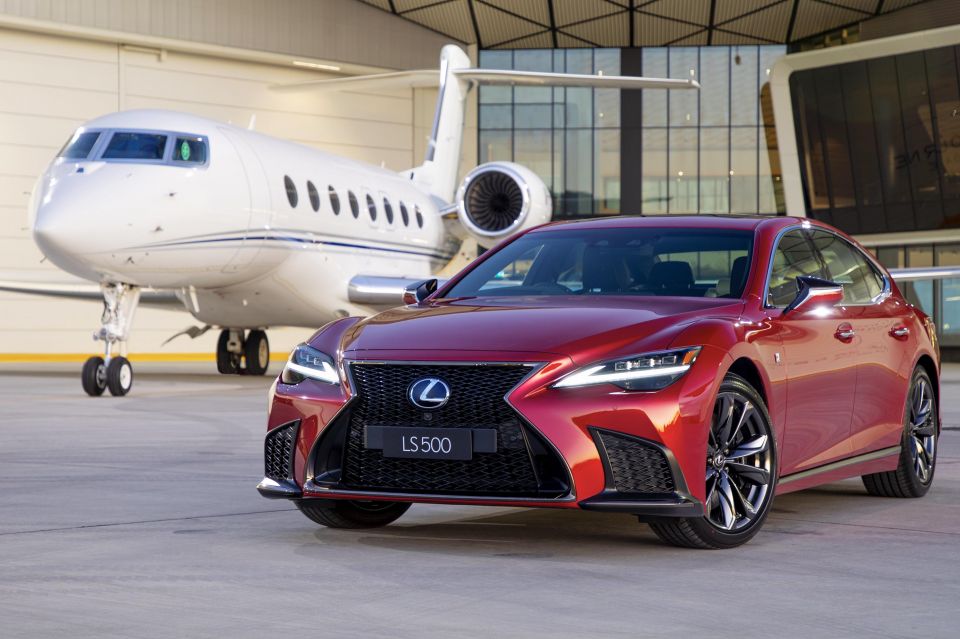


Senior Contributor
New from
$195,325
excl. on-roads

Senior Contributor
New from
$195,325
excl. on-roads


Senior Contributor
New from
$195,325
excl. on-roads

Senior Contributor
New from
$195,325
excl. on-roads
Quickly see how this car stacks up against its competition. Select any benchmark to see more details.
Where expert car reviews meet expert car buying – CarExpert gives you trusted advice, personalised service and real savings on your next new car.
Lexus captured lightning in a bottle with the first LSmore than 30 years ago. Fanatical attention to detail and Toyota’s bottomless pockets made it a marvel that undercut yet outgunned its German competitors.
The brand will probably never have such a golden opportunity to change the world of motoring again. Its rivals are too savvy and its R&D budget too diffuse.
But the LS nameplate remains its flagship, the jewel in its crown.

This is the vehicle designed to tackle the Mercedes-Benz S-Class, BMW 7 Series, and Audi A8.
A few years into its life cycle, the sleek fifth-generation model has picked up a suite of updates for the 2021 model year designed to make it even cushier than before, and higher-tech to boot.
It also looks as beautiful as ever – more so if you ask me, since those old zig-zagging headlights have been swapped for sleeker and cleaner units.
By the way, read our deep-dive into the Lexus LS’s storied history here.
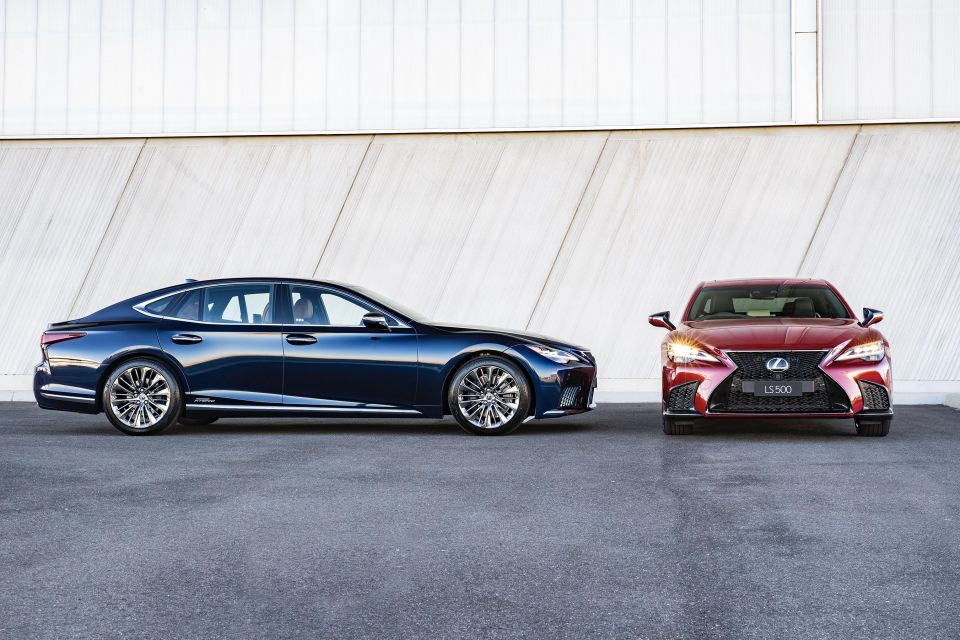
There are two specification grades available, both sold with twin-turbo V6 (LS500) or hybrid (LS500h) engines.
The LS500 and LS500h F Sport each cost $195,953, and the LS500 and LS500h Sports Luxury variants are both $201,078. All prices are before on-road costs.
That’s about the same as the base diesel A8 and 7 Series variants.
However, unlike the German products that tend to come with options lists as long as your arm (a good or bad thing depending on your viewpoint and bank balance), Lexus packages almost everything in the company cupboard as standard.
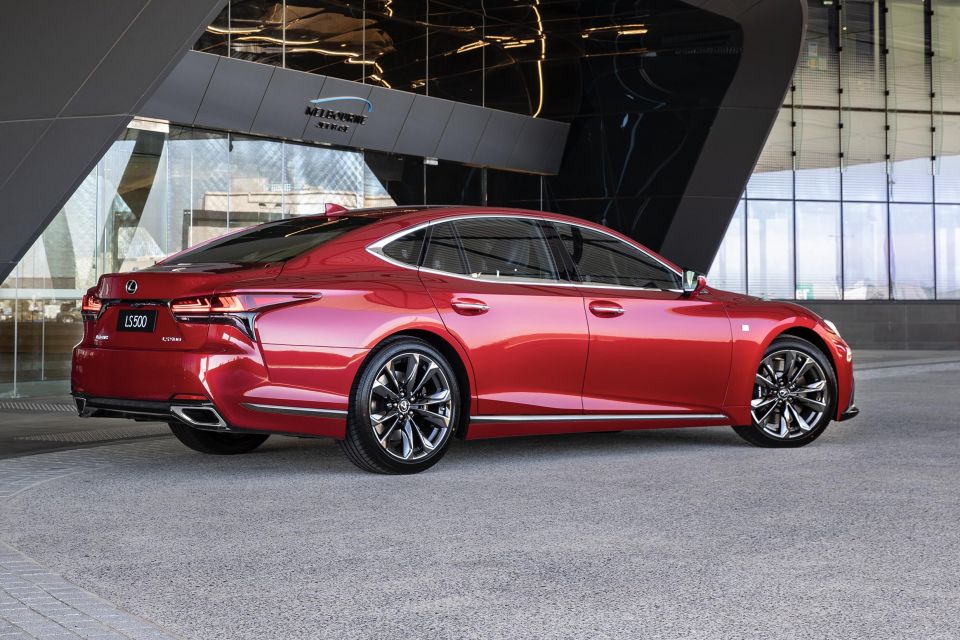
Buy your new car without the stress. It's fast, simple and completely free.

Great service from Travis and team, second time I have used this business would not hesitate to recommend them to anyone
Craig C.
Purchased a Ford Ranger in Sunshine Coast, QLD
CarExpert helped Craig save thousands on his Ford Ranger, now let us save you on your next new car.
Find a dealRegardless of grade you get adaptive LED headlights and LED daytime-running lights, sequential indicators, a sunroof, hands-free power-operated boot lid, proximity key access, soft-closing doors, automatic wipers, illuminated door handles, puddle lamps, and 20-inch alloy wheels.
Inside there are heated and ventilated front seats with 28-way electric adjustment and memory presets, a heated leather steering wheel, an electric rear sunshade, a digital rear-view mirror that displays a rear-facing camera view, a large projecting head-up display, and auto climate control with infrared body temperature sensors.
There’s a 12.3-inch touchscreen fitted to the update in place of the old touchpad-only system, featuring satellite-navigation and phone mirroring. There’s a 360-degree camera, DAB+ radio, four USB points, a rather dated DVD player, and a thumping 23-speaker Mark Levinson sound system.

Features unique to the LS500 and LS500h F Sport variants include dark metallic wheels; uprated brakes; rear-wheel steering; two-zone climate control; a driver display borrowed from the LFA with a moving central ring; and a distinctive wheel, shifter, clock and pedals.
The LS500 and LS500h Sports Luxury come with four-zone climate control, digital instruments ringed in leather, higher-grade (semi-aniline) leather, and a front seat relaxation system. There are also reclining back seats with ventilation and massage modes, a pair of 11.6-inch screens with HMDI input, a rear cooler box, and back-seat-cushion airbags.
There are 12 paint options, all at no cost, and nine interior colour themes including Moon White, Crimson Fire, Herringbone, Hazel, Ochre, and Black. There’s also wood, cut Kiriko glass, metal leaf, and platinum cabin trim options.

There’s no ANCAP crash score available, so we can’t really say with 100 per cent certainty. Every other Lexus tested has a five-star score.
There are numerous new active safety features added, including an expanded radar- and camera-guided autonomous emergency braking system that works in intersections and can brake and tighten the seatbelt if it detects a vehicle approaching from diagonally.
There’s also quite effective active steering- and lane-assist with lane-centring, active cruise control that brings the car to stop, road-sign assist, cross-traffic alert, and blind-spot monitoring.
The updated LS also picks up Lexus Connected Services, including automated collision notification, emergency SOS call with GPS coordinates fed to 000, and stolen vehicle tracking. The F Sports has 10 airbags and the Sports Luxury 12.

Almost indecently beautiful, if luxury materials and quality are your priority. Those new, more padded seats are worth the price of admission alone.
Buttery stitched leather covers damn near every surface of the doors and dash, and the deep-pile carpet feels stripped out of a penthouse suite. The electric steering column is silent, and every button and switch is either damped, knurled or rubbery.
There are also tasteful contrast trims (save that piano black), and the optional ornamental glass, aluminium or laser-cut metallic inserts in wood add a genuinely special touch.

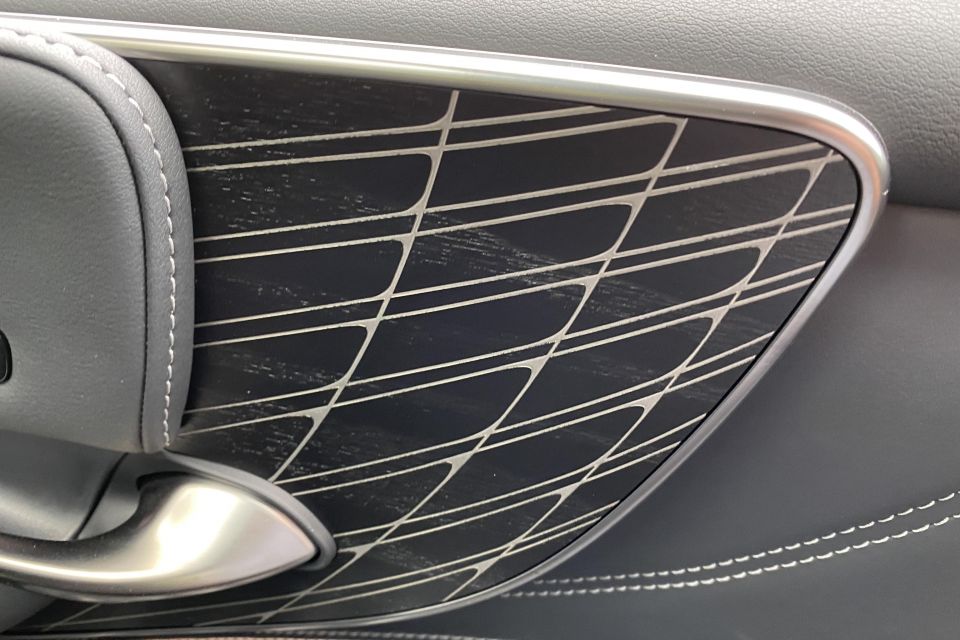
Other features like the pleated door padding, suede roof- and pillar linings, and cabin lighting designed to be reminiscent of Andon lighting are equally lovely.
I’m so glad Lexus has embraced its Japanese roots, by venerating ‘Takumi’ craftwork. It’s a true point-of-difference the brand has always craved, beyond the experiential.
There are two driver instrument displays. The moving metal ring in the F Sport’s makes it my pick of the pair. You can view most key functions in the HUD, though tech junkies might prefer more digitised configurations in the binnacles.
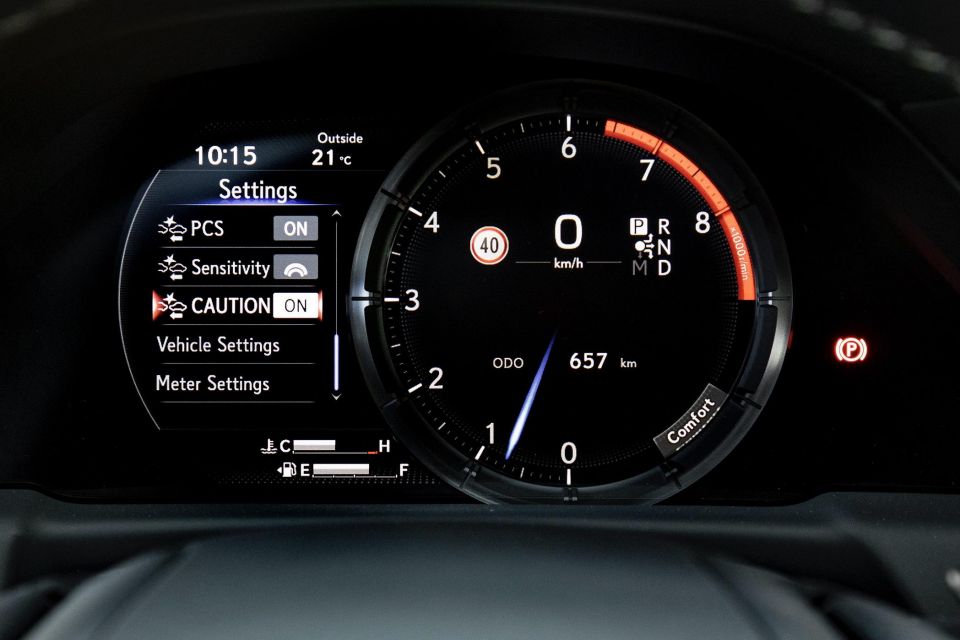

The infotainment system is displayed on a 12.3-inch screen which has been pulled forward and made touch-sensitive, though you can still use the fiddly Lexus Remote Touch laptop-style trackpad with button shortcuts if you prefer.
It’s way more intuitive than before, though the maps are still similar to a Toyota’s, and the software lacks the graphical sparkle and glitz of the magnificent new Mercedes-Benz S-Class, or any equivalent Audi or BMW.
There’s no augmented-reality navigation overlays, conversational voice control, wireless charge pad, 3D displays, haptic feedback pads, or copious over-the-air updates for example. And the rear camera view is grainy. Do you mind? Some people surely will.


Mercifully, the ventilation controls are still hard points. And I cannot express how awesome that Mark Levinson sound system is with mere words. I heard new notes and deeper, richer sounds in some of my favourite songs than I had before.
In short, then, the material quality, tactility, and audio quality, are all beyond reproach. But the interior infotainment remains well behind the best limos out of Europe. Be aware of your priorities and choose accordingly.
The back sure looks exciting, especially the Sports Luxury variants’ Business Class airline seats that recline, and can toast your butt while massaging you. There are also rear vents, plug-in points, and sun shades behind you and alongside you.



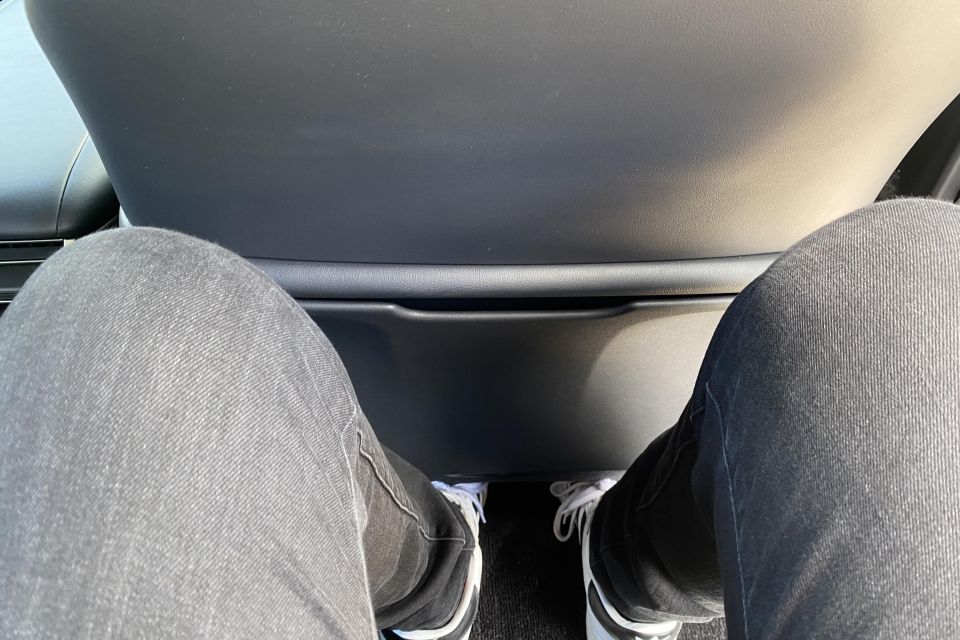
But, I reckon both toe room and rear headroom could and should be better.
I’m taller than the average person (194cm), but there are plenty of potential chauffeur customers my height. Some reviewers had no issue, so it’s a user-by-user case.
The boot is also a bit small too, at a maximum of 480 litres but cut to as low as 400L with the rear cooler. In other words, the boot is at best no larger than a much shorter Lexus IS’s.

There are two Euro 6-compliant petrol-fuelled engines on offer, both driving the rear wheels. They’re more or less the same as the 2020 model’s, but sport some small tweaks here and there.
The more popular of the pair is a claimed 3.5-litre twin-turbocharged V6, though its displacement of 3445cc makes it a 3.4-litre by my calculations…
It makes a healthy 310kW of power at 6000rpm and 600Nm of torque between 1600 and 4800rpm, and is mated to a 10-speed automatic that’s capable of skipping a ratio on downshifts. The zero to 100km/h time is 5.0 seconds.

Lexus has revised the engine’s electric wastegate valve with the stated aim of improving the speed of throttle response. It’s also fitted new pistons with a quieter stroke, a lighter intake manifold, and wider crank pins.
The other option is the hybrid, which joins a 220kW and 350Nm 3.5-litre V6 with a 132kW/300Nm permanent magnet electric motor. The maximum system power is 264kW, since the engine and motor never max out concurrently, and is claimed to be on tap from about 50km/h.
The revised 311V lithium-ion battery runs the motor and is charged by both the engine-generator and brake-energy recuperation. Lexus says the system can now decouple the engine and coast electrically at speeds of 129km/h (previously 70km/h), and claims it has slashed the engine’s stop/start frequency on highways.

Where expert car reviews meet expert car buying – CarExpert gives you trusted advice, personalised service and real savings on your next new car.
The LS500h hybrid transmission is a complex thing. In short, it’s a stepped e-CVT automatic plus a four-speed transmission. It basically means you have 10 ratios controlled by the power control unit. The 4AT unit is there to give the car a more natural feel off the mark, with pronounced shifts.
Lexus claims the LS500h hybrid slashes fuel economy to 6.6 litres per 100km on a combined-cycle loop, compared to 10L/100km for the LS500.
It also cuts CO2 emissions from 227 grams per kilometre to 150g/km. The 0-100km/h time is four-tenths slower at a still sprightly 5.4sec.

The LS500’s V6 is the pick of the engines. It has absolutely no issues with pickup thanks to plenty of low-down torque. It has a raspy note too, though there’s so much firewall insulation that under revs its sounds as though it’s 50m away.
One fellow motoring writer mentioned over coffee that he felt the occasional minor shunt from the gearbox, though I personally found it syrupy and well-tuned to the vehicle’s purpose.
The hybrid certainly suits the vehicle well, given its excellent refinement and ability to waft along at low speeds electrically for short distances. As with all Toyota/Lexus systems, the changeover from engine to motor power and vice-versa is near-imperceptible in urban and highway commuting.

But for the wealthy punter, the faster option usually appeals more than saving a few litres of dinosaur juice. If you want a hi-po V8, plug-in hybrid, or EV – all of which feature in this segment of vehicle – Lexus offers none of the above.
Dynamically, what has changed?
Not a heap, since the current generation’s super-stiff architecture made it much more dynamically polished than its predecessors from the start.
Tweaks include new hollow-chamber wheels to lower acoustic outputs, and a new Bridgestone tyre design that supposedly reduces road-surface inputs that you feel in the chair bases. Yes, tyres make a big difference to ride comfort.

Other changes include new solenoids and control valves for the adaptive variable suspension system, bigger lower control-arm bushings, new bump stops, and revised front and rear stabiliser bars.
The gist is that Lexus wants this revised LS to be plusher and quieter than before.
There are still various driving modes controlled by a fixed stalk mounted on the left-hand side of the instrument binnacle, which alter the degree of body movement through elevation changes and over bumps.

As before, the F Sport models get rear-wheel steering, variable-ratio steering, active body stabilisers, and bigger brakes. There’s also height-adjustable multi-link front and rear air suspension on both the Sports Luxury and F Sport.
For a 5235mm long sedan that weighs as much as 2340kg (kerb), the LS is actually pretty fun to drive, particularly in F Sport guise with superior high-speed stability in sweeping corners.
It’s obviously no corner-carver and the steering is pretty uncommunicative, but the body control is good and directional changes satisfactory. It feels stiff, solid and stable, and doesn’t mind being punted along with a little veracity.
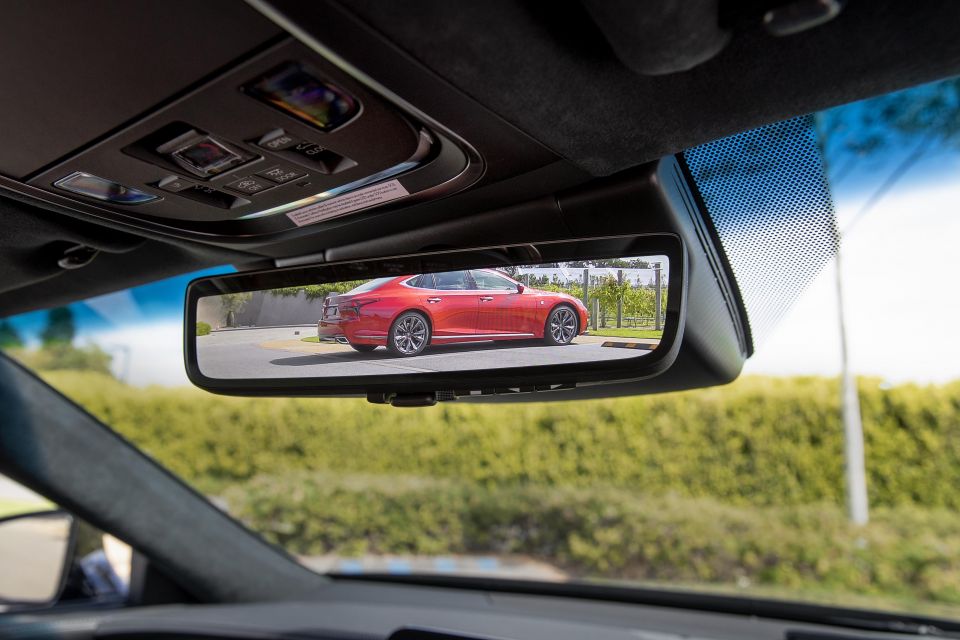
Its real dynamic strength, though, is refinement. On the launch event I did a quick sound check at 105km/h on a smooth highway and saw 59dB. That’s barely louder than a humming refrigerator. On coarser-chip surfaces I saw 64dB, which is still quiet enough to communicate by whispering.
The ride does feel a little better too. I recall the pre-update model being a little louder over sharp hits such as expansion joints and potholes, though on a quick launch drive without a back-to-back against the old car it’s always hard to be certain.
I also like the digital rear-view mirror with a live camera feed. Once you adjust it becomes indispensable, though you can flick it off easily and revert to a regular mirror.

Lexus offers a four-year warranty and capped servicing priced at $1785 for the first three visits (covering 36 months or 45,000km).
It also is famous for its customer care, and LS buyers get the flagship ‘Lexus Encore Platinum’ benefits program, as you’d expect.
You get a free loan car or from-home pickup come service time, a wash and vacuum, roadside assistance, invites to Lexus-sponsored events, restaurants and hotels, and valet parking at various shopping malls.

If you’re after a limousine with neck-snapping pace off the line or the most sophisticated in-cabin screens and technologies, then the Lexus LS takes a back seat to the German competitor set.
And on the subject of back seats, I think Lexus’s decision to make the LS look so sleek has impacted rear headroom, which is a little tight for taller folk.
However, there are many areas where this LS absolutely shines. It’s quiet, plush, handsome as hell, and its interior quality is sublime. Plus by all accounts and market research surveys, the Lexus ownership experience is second to none.
The MY21 updates improve the LS by increments. It’s a car with a clear identity, and one that focuses on Lexus’s real strengths.

Click the images for the full gallery
Where expert car reviews meet expert car buying – CarExpert gives you trusted advice, personalised service and real savings on your next new car.


William Stopford
4 Hours Ago


Josh Nevett
5 Hours Ago


Ben Zachariah
21 Hours Ago


CarExpert.com.au
1 Day Ago


Damion Smy
2 Days Ago


Damion Smy
2 Days Ago